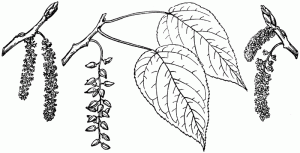Balm of Gilead

She went on to explain that her friend had been plagued by eczema for years, and even prescription ointments and numerous visits to doctors had failed to stop his weeping and festering rashes. Within a week of applying the Balm of Gilead ointment she had given him his eczema subsided and never came back.
This amazing story prompted me to do some immediate research into the subject, I found it a fascinating story.
If you decide to collect some buds to try this out, be sure not to pick any from the tips of the branches. These tip buds draw the sap out the length of the branch, so removing them can stop the flow for the whole branch.
Balm of Gilead is made from the sticky leaf buds of the common Balsam Poplar or cottonwood tree, you know, those things that stick so tenaciously to the hood of your car after a wind storm if you are anywhere near a cottonwood tree. And you are probably aware that we have got a lot of these trees growing in our river valley…it’s the perfect growing environment for them. As it turns out, the balsam poplar has a long history of use, both medicinal and practical, by a number of native North American Indian tribes. In fact, after I got done reading about the many uses of this tree I wondered why this information isn’t more widely known.
There are many herbalist websites online that tell you a number of ways to harvest and utilize the buds. The simplest way to make a therapeutic oil is to simply steep the poplar buds in a carrier oil, such as olive oil or almond oil, and then applying it as needed to rashes, insect bites, aches, inflammation and so on. If you want to get fancy and make it more portable you can turn it into an ointment by mixing it with beeswax.
I was further intrigued to find that even bees make good use of the poplar tree…they use the sticky resin from the buds as both a sealant for their hives and an anti-infectant against bacterial invasions.
The buds contain salicylates, the base of aspirin, which makes for the anti-inflammatory and analgesic properties of the resin. The resin is also anti-microbial (which those amazing bees figured out somehow) and it stimulates skin growth. It can be diffused into steam to help heal lung disorders, infections, coughs and nasal congestion. The buds are also full of anti-oxidants, so infused oils and ointments don’t go rancid.
It’s just about fly season here again, and it appears that the poplar tree is even useful in repelling pesky biting critters. Rubbing the resin on your skin helps repel insects, as does smoke from burning the bark.
And then if you do get chewed up Balm of Gilead will help soothe your bites!
In Europe fresh flowers of the balsam poplar are steeped in cold water, then strained and drunk to purify the blood.
An extract of the shoots can be used as a rooting hormone for all types of cuttings, as well. I thought this was fairly apt as poplars can rapidly take over a field and their root are very invasive in drainage ditches and sewers…you can’t hardly keep them down!
